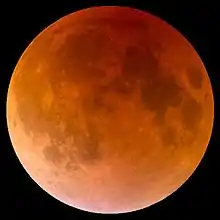May 1910 lunar eclipse
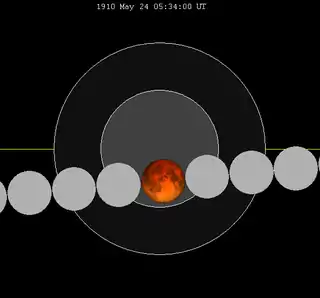
A total lunar eclipse took place on May 24, 1910.
Eclipse season
This event followed the total solar eclipse of May 9, 1910.
Visibility
It was completely visible over Australia, the Americas, Europe and Africa, seen rising over Australia and setting over Europe and Africa.
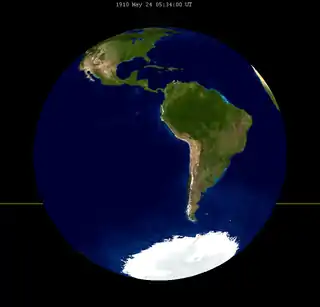
Related lunar eclipses
Saros series
Lunar saros series 129, repeating every 18 years and 11 days, containing 71 events, has 11 total lunar eclipses. The first total lunar eclipse of this series was on May 24, 1910, and last will be on September 8, 2090. The two longest occurrence of this series were on July 6, 1982 and July 16, 2000 when totality lasted 106 minutes.
| Greatest | First | |||
|---|---|---|---|---|
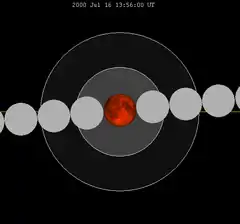 The greatest eclipse of the series occurred on 2000 Jul 16, lasting 106 minutes. |
Penumbral | Partial | Total | Central |
| 1351 Jun 10 | 1513 Sep 15 | 1910 May 24 | 1946 Jun 14 | |
| Last | ||||
| Central | Total | Partial | Penumbral | |
| 2036 Aug 7 | 2090 Sep 8 | 2469 Apr 26 | 2613 Jul 24 | |
| 1910 May 24 | 1928 Jun 3 | 1946 Jun 14 | |||
 |
 |
 |
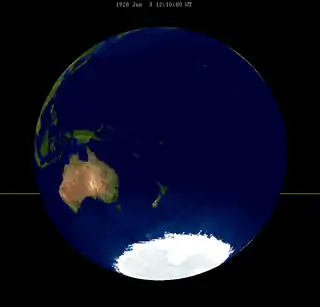 |
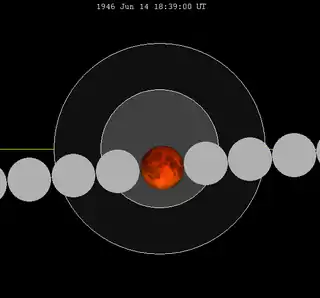 |
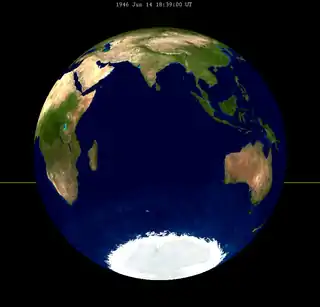 |
| 1964 Jun 25 | 1982 Jul 6 | 2000 Jul 16 | |||
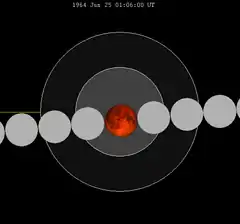 |
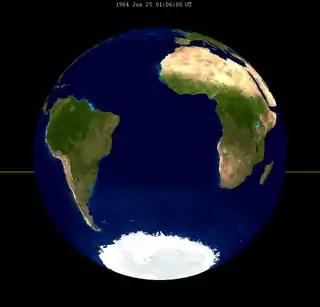 |
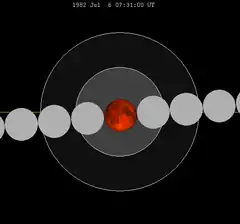 |
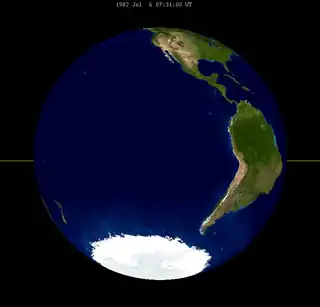 |
 |
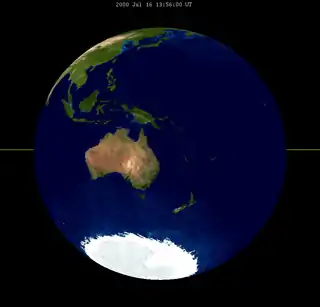 |
| 2018 Jul 27 | 2036 Aug 7 | 2054 Aug 18 | |||
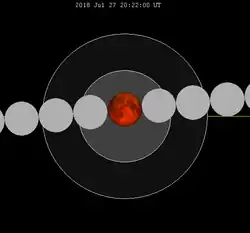 |
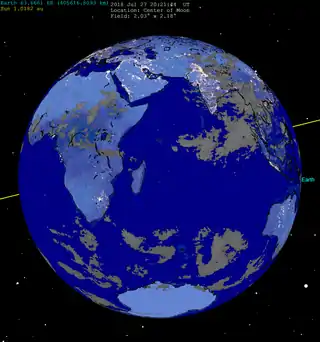 |
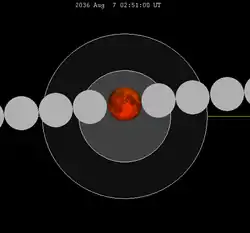 |
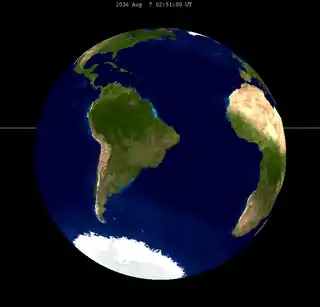 |
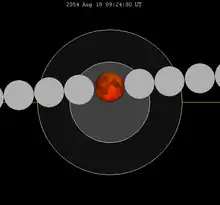 |
 |
| 2072 Aug 28 | 2090 Sep 8 | ||||
 |
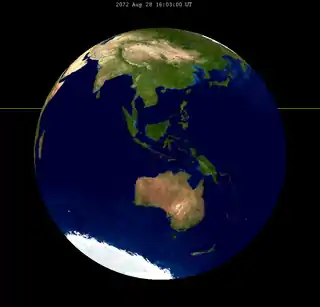 |
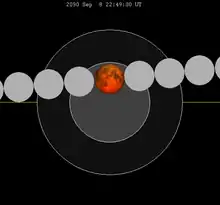 |
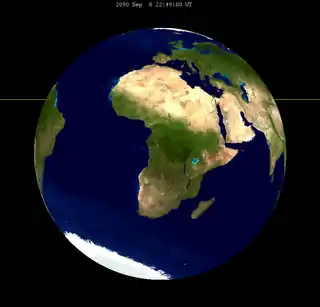 | ||
It last occurred on May 11, 1892 and will next occur on June 3, 1928.
This is the 32nd member of Lunar Saros 129, and the first total eclipse. The next event is the June 1928 lunar eclipse. Lunar Saros 129 contains 11 total lunar eclipses between 1910 and 2090. Solar Saros 136 interleaves with this lunar saros with an event occurring every 9 years 5 days alternating between each saros series.
Inex series
The inex series repeats eclipses 20 days short of 29 years, repeating on average every 10571.95 days. This period is equal to 358 lunations (synodic months) and 388.5 draconic months. Saros series increment by one on successive Inex events and repeat at alternate ascending and descending lunar nodes.
This period is 383.6734 anomalistic months (the period of the Moon's elliptical orbital precession). Despite the average 0.05 time-of-day shift between subsequent events, the variation of the Moon in its elliptical orbit at each event causes the actual eclipse time to vary significantly. It is a part of Lunar Inex series 35.
| Descending node | Ascending node | Descending node | Ascending node | ||||
|---|---|---|---|---|---|---|---|
| Saros | Date Chart |
Saros | Date Chart |
Saros | Date Chart |
Saros | Date Chart |
| 115 | 1505 Feb 18 |
116 | 1534 Jan 30 |
117 | 1563 Jan 9 | 118 | 1591 Dec 30 |
| 119 | 1620 Dec 9 | 120 | 1649 Nov 19 | 121 | 1678 Oct 29 | 122 | 1707 Oct 11 |
| 123 | 1736 Sep 20 | 124 | 1765 Aug 30 | 125 | 1794 Aug 11 | 126 | 1823 Jul 23 |
| 127 | 1852 Jul 1 | 128 | 1881 Jun 12 | 129 | 1910 May 24 |
130 | 1939 May 3 |
| 131 | 1968 Apr 13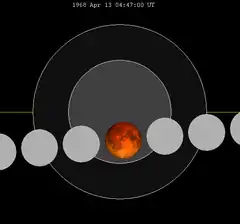 |
132 | 1997 Mar 24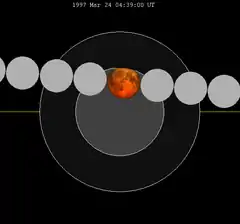 |
133 | 2026 Mar 3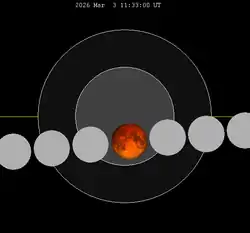 |
134 | 2055 Feb 11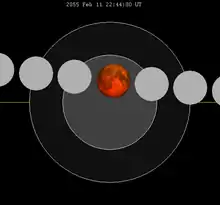 |
| 135 | 2084 Jan 22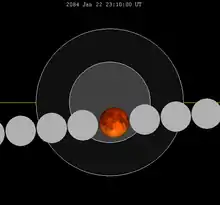 |
136 | 2113 Jan 2 | 137 | 2141 Dec 13 | 138 | 2170 Nov 23 |
| 139 | 2199 Nov 2 | 140 | 2228 Oct 14 | 141 | 2257 Sep 24 | 142 | 2286 Sep 3 |
| 143 | 2315 Aug 16 | 144 | 2344 Jul 26 | 145 | 2373 Jul 5 | 146 | 2402 Jun 16 |
| 147 | 2431 May 27 | 148 | 2460 May 5 |
149 | 2489 Apr 16 | ||
Half-Saros cycle
A lunar eclipse will be preceded and followed by solar eclipses by 9 years and 5.5 days (a half saros).[1] This lunar eclipse is related to two total solar eclipses of Solar Saros 136.
| May 18, 1901 | May 29, 1919 |
|---|---|
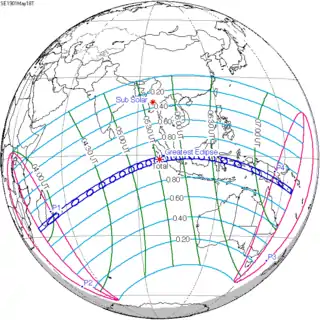 |
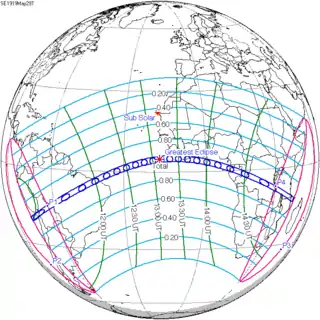 |
See also
- List of lunar eclipses
- List of 20th-century lunar eclipses
Notes
- Mathematical Astronomy Morsels, Jean Meeus, p.110, Chapter 18, The half-saros

